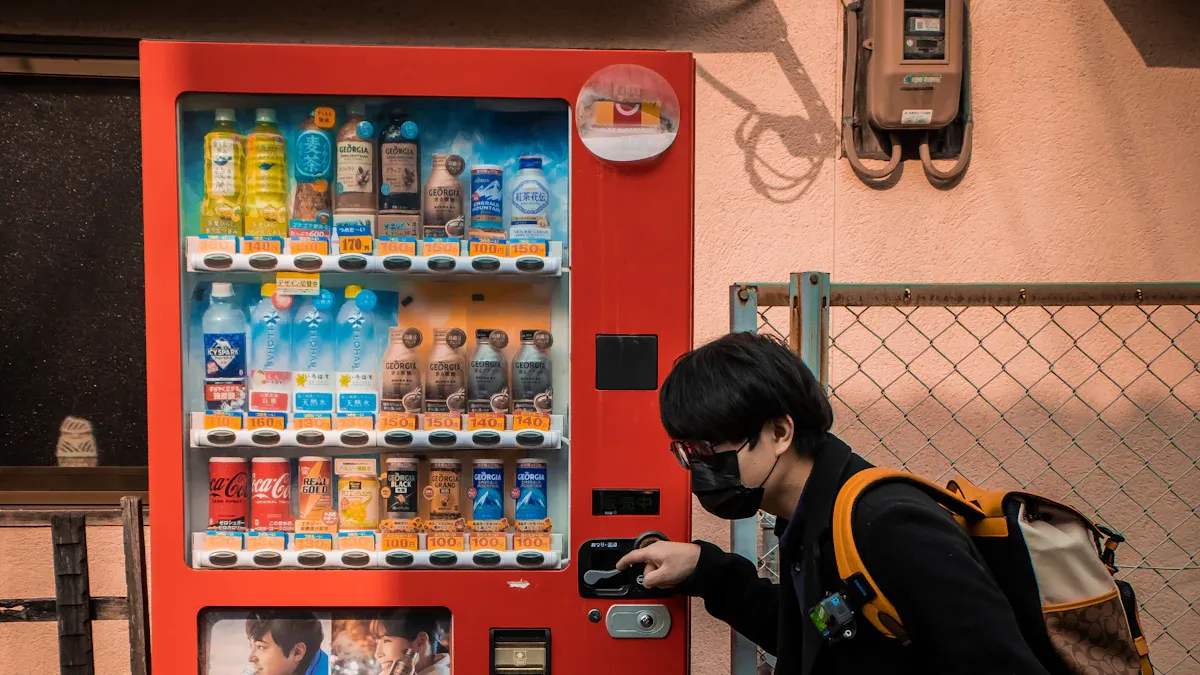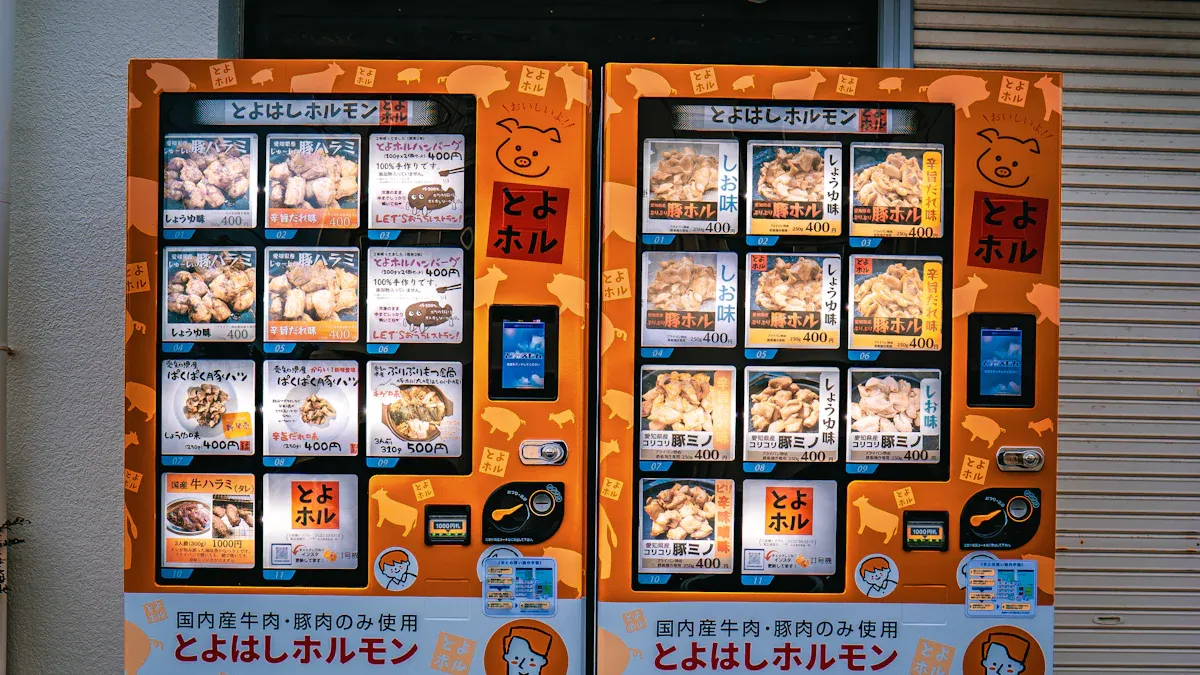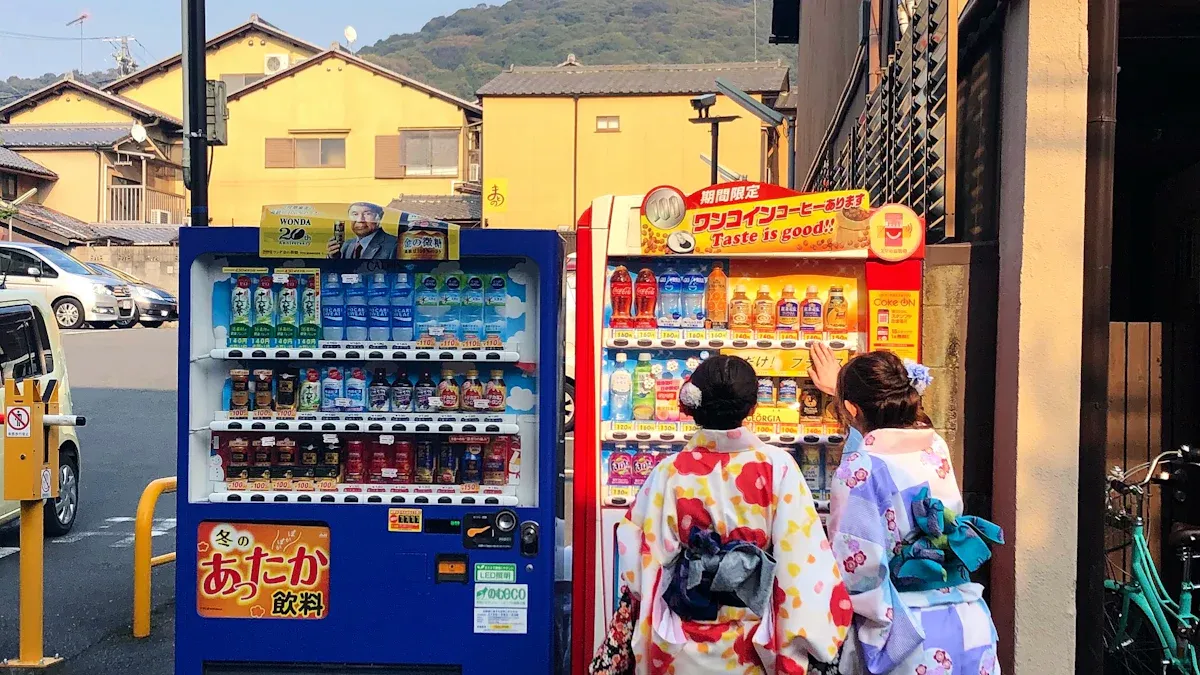Japan's Vending Machine Culture

If you’ve ever visited Japan, you know that Japan's vending machine culture is everywhere—on busy streets, quiet alleys, and even in rural villages. This isn’t just about convenience; it’s a reflection of trust and efficiency in Japanese society. With over 5.5 million vending machines across the country, Japan boasts the highest ratio of machines per person globally. That means there’s one for every 23 people! This culture of convenience ensures you can grab a drink or snack anytime, anywhere. It’s a seamless convenience that makes Japan's vending machine culture truly fascinating.
Key Takeaways
Japan has over 5.5 million vending machines. They are important in daily life and show convenience.
These machines sell many things, like hot meals and fresh flowers. This shows Japan's creativity and flexibility.
New technology, like AI and cashless payments, makes using them easier. Buying is now faster and more personal.
Japan's low crime rate helps people trust vending machines. They can be placed even in faraway areas without worry.
Eco-friendly vending machines are becoming popular. They use solar power and save energy to help the environment.
A Brief History of Japan's Vending Machine Culture
Early origins and the first vending machines in Japan
Did you know Japan’s vending machine journey began in the late 19th century? The very first vending machine was created by Tawaraya Koshichi in 1888. It wasn’t anything like the high-tech machines you see today. Instead, it dispensed tobacco, which was a popular product at the time. This invention was a big deal and even earned a spot at the 3rd National Industrial Exhibition in Ueno in 1890.
By the early 1900s, vending machines started offering more variety. You could find machines selling stamps, postcards, and even sake. These early models laid the foundation for what would eventually become a booming vending machine industry in Japan.
Post-WWII expansion and popularity
After World War II, Japan saw a rapid transformation in its economy and lifestyle. This was when vending machines truly started to shine. In the 1950s, machines selling juice and beer became incredibly popular. They were convenient, reliable, and fit perfectly into the fast-paced lives of post-war Japan.
By 1964, there were already 240,000 vending machines across the country. This number skyrocketed to 1 million by 1970. The vending machine culture was no longer just about convenience—it became a symbol of modernity and innovation.
Key milestones in vending machine development
Japan’s vending machine culture has hit some impressive milestones over the years. Here’s a quick look at how it evolved:
Year | Milestone Description |
|---|---|
1888 | First vending machine invented by Tawaraya Koshichi |
1950s | Juice and beer vending machines gained popularity |
1964 | 240,000 vending machines in operation |
1970 | Number of machines reached 1 million |
1984 | Total machines grew to 5 million |
By 2000, the number of vending machines peaked at 5.6 million. However, the rise of convenience stores and fewer machines selling alcohol and cigarettes caused a slight decline. Today, Japan still boasts around 5.4 million vending machines, proving that they remain an integral part of daily life.
The Variety in Japan's Vending Machine Culture

Everyday essentials: Drinks, snacks, and meals
When you think of vending machines, you probably imagine grabbing a quick drink or snack. In Japan, this is just the beginning. Japanese vending machines offer a wide range of everyday essentials, making them a reliable part of daily life. You’ll find vending machine drinks like soda, coffee, and even vending machine green tea, also known as ryokucha. Whether you’re craving something cold on a hot summer day or a warm beverage in winter, these machines have you covered.
Hot food vending machines are another highlight. Imagine walking up to a machine and getting a steaming bowl of noodles or a freshly cooked burger. These machines are perfect for busy commuters or anyone looking for a quick, satisfying meal. Vending machine food in Japan isn’t just convenient—it’s surprisingly delicious.
Unique offerings: Unusual items and regional specialties
Japan’s vending machines are famous for their creativity. You’ll find unique vending machines selling items you’d never expect. Need a fresh pair of socks? There’s a machine for that. How about a bouquet of flowers or even a tie for an unexpected meeting? Yes, those exist too.
Some machines cater to regional specialties, offering products that reflect the local culture. For example, in certain areas, you can buy rice straight from a vending machine. In others, you might find locally brewed sake or even fresh eggs. These vending machine offerings showcase the diversity and ingenuity of Japan's vending machine culture.
Seasonal products and limited-edition items
One of the most exciting aspects of Japanese vending machines is their seasonal and limited-edition products. Japan loves celebrating the seasons, and vending machines are no exception. In spring, you might find cherry blossom-themed drinks. During the winter, hot food vending machines often feature hearty soups or stews to keep you warm.
Limited-edition items are another big draw. Japanese green tea brands often release special flavors that you can only find for a short time. These exclusive products make vending machines feel like treasure chests, offering something new and exciting every time you visit.
Japan’s vending machine culture isn’t just about convenience. It’s a reflection of the country’s creativity, adaptability, and love for innovation. Whether you’re grabbing a quick drink, exploring unique vending machines, or hunting for seasonal treats, there’s always something to discover.
Technological Innovations in Japan's Vending Machines

AI and smart vending machines
Have you ever wondered how vending machines in Japan always seem to have what you need? That’s thanks to AI and IoT (Internet of Things) technologies. These smart vending machines track inventory in real time, ensuring popular items are always stocked. They even predict when maintenance is needed, so you rarely encounter an out-of-order machine.
Some machines go a step further by offering personalized recommendations. Using AI, they analyze your purchase history or even the weather to suggest the perfect drink or snack. For example, on a hot day, the machine might recommend a cold soda. These innovations make Japanese vending machines feel almost human in their ability to meet your needs.
Cashless payments and smartphone integration
Carrying cash is becoming less common, and Japan’s vending machines are keeping up. Many now accept contactless payments, mobile wallets, and even QR codes. This shift makes transactions faster and safer, especially in a post-pandemic world.
Here’s a quick look at how cashless payments are transforming the vending machine industry:
Innovation Type | Description |
|---|---|
Cashless Payment Options | Machines now accept mobile wallets and contactless cards for added convenience. |
Digital Wallets | The rise of digital wallets is driving the evolution of vending technology. |
NFC Technology | Near Field Communication (NFC) allows for seamless, instant transactions. |
These advancements don’t just make life easier for you. They also help vending machine operators by speeding up transactions and reducing the need for cash handling.
Eco-friendly and energy-efficient designs
Japan is serious about sustainability, and its vending machines are no exception. Many now feature eco-friendly designs that reduce energy consumption. For instance, Coca-Cola Japan introduced "peak shift" machines that cut daytime power use by 95% during summer. In winter, these machines still save 20% more energy compared to traditional models.
Some machines even run on solar power, aligning with Japan’s green energy goals. Nestlé has also joined the movement with vending machines that use 40% less energy. These innovations show how the vending machine industry is adapting to environmental challenges while maintaining convenience for you.
The Cultural Significance of Vending Machines in Japan
Trust and low crime rates enabling their success
Have you ever wondered why vending machines are everywhere in Japan, even in the most remote areas? It all comes down to trust. Japan’s low crime rate plays a huge role in the success of its vending machine culture. These machines are often left unattended in public spaces, something that might seem risky in other countries. But in Japan, vandalism is rare.
Most vending machines are equipped with cameras, which are often linked directly to local police stations. This added layer of security ensures that these machines remain safe and functional. Another interesting point? Violent protests or demonstrations are uncommon in Japan, which means vending machines are rarely damaged during public events. This level of societal trust creates the perfect environment for vending machines to thrive.
The role of vending machines in urban and rural areas
Vending machines are everywhere in Japan, but their role changes depending on where you are. In cities, they’re a lifeline for busy people. You’ll find machines offering everything from hot meals to electronics. They’re designed to keep up with the fast-paced urban lifestyle.
In rural areas, vending machines take on a different role. They often provide basic necessities like drinks and snacks, especially in places where convenience stores are scarce. Some even sell local specialties, like fresh produce or regional snacks. Here’s a quick comparison of how vending machines differ between urban and rural settings:
Aspect | Urban Settings | Rural Settings |
|---|---|---|
Product Variety | Extensive, including food and electronics | Limited, focusing on basic necessities |
Technological Innovation | High, with advanced features and options | Moderate, with standard machines |
Cultural Significance | Integral to fast-paced urban life | Reflects local traditions and needs |
No matter where you are, vending machines adapt to meet the needs of the community. They’re not just convenient—they’re essential.
How vending machines reflect Japanese societal values
Japanese vending machines are more than just machines. They’re a reflection of the country’s values. For one, they emphasize politeness. Some machines even say “thank you” after you make a purchase. This small gesture shows the importance of respect in Japanese culture.
The design of these machines also highlights user-friendliness. They’re easy to use, with clear instructions and intuitive layouts. This focus on convenience mirrors Japan’s culture of convenience, where everything is designed to make life easier for you.
Some vending machines go beyond selling products. They provide updates on current events or display local news. This blend of functionality and cultural engagement shows how deeply vending machines are woven into daily life. It’s no wonder Japan is often called a vending machine wonderland.
In every way, Japanese vending machines reflect the cultural significance of trust, respect, and innovation. They’re not just about selling products—they’re about creating a seamless experience that aligns with the values of Japanese society.
Future Trends in Japan's Vending Machine Culture
Sustainable and green vending machine initiatives
Japan is leading the way in making vending machines more eco-friendly. You’ll find machines powered by solar energy, offering not just convenience but also a greener footprint. These machines cater to eco-conscious consumers by providing healthy snacks while reducing energy consumption. One standout innovation comes from ASAHI SOFT DRINKS CO., LTD., which is testing a vending machine that absorbs CO2 from the atmosphere. Imagine grabbing a drink while contributing to a decarbonized future—it’s a win-win!
These initiatives reflect Japan’s commitment to sustainability. By integrating green technology into everyday life, vending machines are evolving into tools for environmental change. It’s a small step with a big impact, showing how even a simple machine can help create a more sustainable world.
AI-driven personalization and user experiences
Have you ever wished a vending machine could read your mind? In Japan, that’s almost a reality. Advanced vending machines now use AI and facial recognition to offer personalized recommendations. For example, the KATE iCON box by Kanebo Cosmetics suggests makeup palettes tailored to your face. It’s like having a personal shopper, but faster and more convenient.
These smart machines don’t just stop at cosmetics. They analyze factors like weather and your purchase history to suggest the perfect product. On a hot day, you might get a recommendation for a refreshing iced tea. This level of personalization enhances your experience and makes vending machines feel more human. With Japan’s love for convenience, it’s no surprise these innovations are thriving.
Predictions for vending machines' evolving role in Japan
The future of vending machines in Japan looks brighter than ever. Experts predict significant advancements, including biometric technologies for secure transactions and AI-driven features for better user interaction. These machines are also expected to adopt alternative energy sources, making them even more sustainable.
The market for vending machines is projected to grow to USD 1118.01 million by FY2032, with a CAGR of 6.12% from FY2025 to FY2032. This growth will likely be fueled by changing consumer preferences and a focus on health-conscious products. As vending machines continue to evolve, they’ll play an even bigger role in daily life, cementing Japan’s reputation as a vending machine wonderland.
Vending machines in Japan are more than just convenient—they’re a cultural icon. With over 5 million machines generating billions in annual sales, they’ve become a vital part of daily life. These machines reflect the country’s innovative spirit, offering everything from hot meals to seasonal treats. Their presence in both urban and rural areas highlights their adaptability and importance.
What makes them truly special is how they embody societal trust. Low crime rates ensure these machines remain safe and reliable, even in remote locations. As technology advances, vending machines are set to become even smarter and greener, shaping the future of convenience. Whether you’re grabbing a quick drink or exploring unique offerings, vending machines continue to redefine how we interact with everyday essentials.
FAQ
What makes Japan’s vending machines so unique?
Japan’s vending machines stand out because of their variety and innovation. You can buy everything from hot meals to fresh flowers. Many machines also feature advanced technology like AI, cashless payments, and eco-friendly designs. They’re more than just convenient—they’re an experience!
Are vending machines only found in cities?
Not at all! You’ll find vending machines everywhere in Japan, even in rural areas. In cities, they cater to busy lifestyles with high-tech options. In the countryside, they often provide essentials like drinks and snacks where stores might be scarce.
How do vending machines stay safe in Japan?
Japan’s low crime rate plays a big role. People respect public property, so vandalism is rare. Many machines also have cameras for added security. This trust ensures vending machines remain accessible and functional, even in remote locations.
Can I use my smartphone to pay at vending machines?
Yes, you can! Many vending machines in Japan accept mobile wallets, QR codes, and contactless payments. This makes transactions quick and easy, especially if you don’t have cash. It’s a modern convenience that fits perfectly into Japan’s tech-savvy culture.
Do vending machines offer seasonal products?
Absolutely! Japan loves celebrating the seasons, and vending machines reflect that. In spring, you might find cherry blossom-themed drinks. Winter machines often feature hot soups or stews. These seasonal treats make vending machines feel fresh and exciting all year round.
See Also
Discovering Tokyo's Unique Sake Vending Machine Culture
Uncovering Tokyo's Fascinating Sake Vending Machines
Vending Machines for Band Merchandise: A New Trend
Grocery Vending Machines Transforming Access to Retail Shopping
The Emergence of 24-Hour Vending Cafes: Innovation and Convenience
